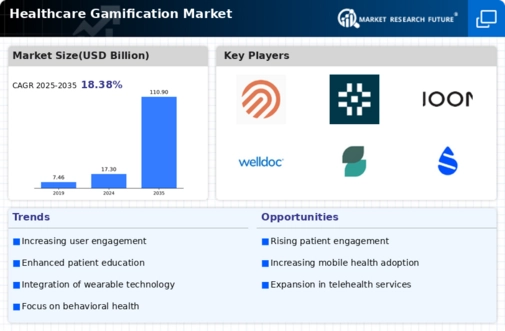Market Growth Projections
The Global Healthcare Gamification Market Industry is projected to experience robust growth in the coming years. With a market value expected to reach 17.3 USD Billion in 2024 and an impressive forecast of 110.9 USD Billion by 2035, the industry is on a trajectory of significant expansion. The anticipated compound annual growth rate of 18.38% from 2025 to 2035 indicates a strong demand for gamified healthcare solutions. This growth is driven by various factors, including technological advancements, increased patient engagement, and a shift towards preventive healthcare. As the market evolves, stakeholders are likely to explore innovative approaches to enhance patient experiences and outcomes.
Rising Demand for Patient Engagement
The Global Healthcare Gamification Market Industry experiences a notable surge in demand for patient engagement solutions. As healthcare providers increasingly recognize the importance of involving patients in their own care, gamification strategies are being integrated into various platforms. These strategies not only enhance patient adherence to treatment plans but also foster a sense of community among users. For instance, mobile applications that reward users for completing health-related tasks are gaining traction. This trend is expected to contribute to the market's growth, with projections indicating a market value of 17.3 USD Billion in 2024, reflecting a growing emphasis on patient-centric care.
Increased Focus on Preventive Healthcare
The Global Healthcare Gamification Market Industry is significantly influenced by the increasing focus on preventive healthcare. As healthcare systems worldwide shift from reactive to proactive approaches, gamification emerges as a valuable tool in promoting healthy behaviors. Programs that incentivize physical activity, nutrition, and regular health screenings are becoming more prevalent. For example, wellness programs that reward participants for achieving fitness goals are gaining popularity among employers. This trend aligns with the broader healthcare objective of reducing long-term costs associated with chronic diseases. The anticipated compound annual growth rate of 18.38% from 2025 to 2035 underscores the potential of gamification in preventive health initiatives.
Technological Advancements in Healthcare
Technological advancements play a pivotal role in the expansion of the Global Healthcare Gamification Market Industry. Innovations such as artificial intelligence, machine learning, and mobile health applications are revolutionizing how healthcare providers interact with patients. These technologies enable the development of sophisticated gamified solutions that can track patient progress, provide real-time feedback, and offer personalized health recommendations. As a result, healthcare organizations are increasingly adopting these tools to improve patient outcomes and operational efficiency. The integration of such technologies is projected to drive the market to an estimated value of 110.9 USD Billion by 2035, highlighting the potential for growth in this sector.
Growing Adoption of Mobile Health Applications
The Global Healthcare Gamification Market Industry benefits from the growing adoption of mobile health applications. With the proliferation of smartphones, patients are increasingly turning to mobile apps for health management. These applications often incorporate gamified elements to enhance user engagement and motivation. For instance, fitness tracking apps that allow users to set goals and earn rewards for achieving them are widely used. This trend not only empowers patients to take charge of their health but also provides healthcare providers with valuable data on patient behavior. As mobile health applications continue to gain traction, the market is poised for substantial growth, reflecting the evolving landscape of healthcare delivery.
Regulatory Support for Digital Health Solutions
The Global Healthcare Gamification Market Industry is bolstered by regulatory support for digital health solutions. Governments and health organizations are increasingly recognizing the potential of gamification to improve health outcomes and reduce healthcare costs. Initiatives aimed at promoting digital health technologies are being implemented, creating a favorable environment for gamified solutions. For instance, policies that encourage the use of mobile health applications and telehealth services are gaining momentum. This regulatory backing not only fosters innovation but also instills confidence in healthcare providers to invest in gamification strategies. As a result, the market is likely to experience accelerated growth in the coming years.

























